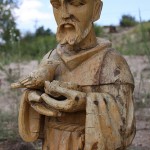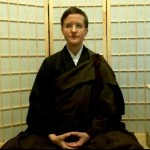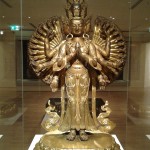 At my Zen center last night I took the risk of departing from our regularly-scheduled programming to bring racism and violence into the mediation hall. This definitely compromised the peacefulness and calm of spiritual community that many of us value as refuge from the turmoil in the rest of the world. However, it seemed like we were missing a practice opportunity if we ignored the news that another white man had been able to shoot and kill an unarmed black man without facing any legal repercussions whatsoever (the night before, the results of the grand jury proceedings around the shooting of Michael Brown had been released, and no indictment was brought against the police officer responsible, Darren Wilson). Although it was uncomfortable to bring a consciousness of sad, confusing, and troubling events into the room, it also seemed wrong to ignore the protests and riots in Ferguson and across the country, the growing agitation and fear among and against law enforcement personnel, and the fact that young black men aged 15-19 appear to be 21 times more likely to be killed by police officers than their white counterparts (according to a ProPublica analysis). I introduced the discussion by emphasizing that we were not there for debate. Instead, we were there to support one another in our efforts to gain clarity and to act with compassion and wisdom according to our consciences. Within the Zen center community, we give one another the benefit of the doubt that we are, indeed, doing our best in this effort – even if we end up coming to different conclusions. I also suggested the central practice required of us right now was tolerance for ambiguity – allowing our discomfort, sadness, anger, and confusion to be present for a while, and refraining from the attempt to make it all go away by grasping on to inadequate answers. As I frequently do in these cases, I shared a brilliant “Tom the Dancing Bug” comic by Ruben Bolling, released after the Virginia Tech shootings, that illustrates our tendency to deal with our emotional reactions to complex problems by latching on to opinions:
At my Zen center last night I took the risk of departing from our regularly-scheduled programming to bring racism and violence into the mediation hall. This definitely compromised the peacefulness and calm of spiritual community that many of us value as refuge from the turmoil in the rest of the world. However, it seemed like we were missing a practice opportunity if we ignored the news that another white man had been able to shoot and kill an unarmed black man without facing any legal repercussions whatsoever (the night before, the results of the grand jury proceedings around the shooting of Michael Brown had been released, and no indictment was brought against the police officer responsible, Darren Wilson). Although it was uncomfortable to bring a consciousness of sad, confusing, and troubling events into the room, it also seemed wrong to ignore the protests and riots in Ferguson and across the country, the growing agitation and fear among and against law enforcement personnel, and the fact that young black men aged 15-19 appear to be 21 times more likely to be killed by police officers than their white counterparts (according to a ProPublica analysis). I introduced the discussion by emphasizing that we were not there for debate. Instead, we were there to support one another in our efforts to gain clarity and to act with compassion and wisdom according to our consciences. Within the Zen center community, we give one another the benefit of the doubt that we are, indeed, doing our best in this effort – even if we end up coming to different conclusions. I also suggested the central practice required of us right now was tolerance for ambiguity – allowing our discomfort, sadness, anger, and confusion to be present for a while, and refraining from the attempt to make it all go away by grasping on to inadequate answers. As I frequently do in these cases, I shared a brilliant “Tom the Dancing Bug” comic by Ruben Bolling, released after the Virginia Tech shootings, that illustrates our tendency to deal with our emotional reactions to complex problems by latching on to opinions:  We then passed a talking stick around so all 9 of us would have an opportunity to share our thoughts and feelings about the Michael Brown case and surrounding problems and events. I have found a talking stick (only the person holding the stick can speak, so there’s no cross-talk) to be extremely useful in these kinds of situations, even though I still think using one is a little on the corny side. It allows people to speak freely about their feelings, concerns, and opinions with less worry about offending anyone or getting swamped with advice, and it also prevents things from degenerating into agitating and fruitless debate. People spoke of shock, sadness, frustration, and even fury. I heard a general determination to address and take responsibility for our country’s racism. I heard acknowledgements of how we support and participate in systems that are stacked against those with less power. People admitted they didn’t – and perhaps couldn’t – know what actually went on when Michael Brown was shot, or during the tough responses to subsequent protests, but that disturbing patterns couldn’t be denied. There was an admission of the challenges faced by police officers, but there was also a fair amount of anger that the grand jury let Darren Wilson off completely rather than at least bringing against him a lesser charge such as manslaughter. I don’t know if the discussion “helped” any of us. Maybe it was best that it didn’t, if “helping” means it made us feel better, or allowed us to figure out the solution to our problems so we didn’t have to think about them anymore. At the end of the evening I proposed that what we had just done was a form of compassion practice – simply perceiving the cries of the world. Not turning away. This is what the bodhisattva of compassion, Kanzeon, is said to do. I find it radical and comforting to consider that perceiving is a beneficial practice in and of itself. I used to think bodhisattva activity was limited to some kind of active response to suffering – that basically it only counted if you did something. Now, even though I believe we should act whenever our consciences call us to, I have faith that just being an open and present witness is also of service. If we let that cloud of ambiguity, that “incomprehensible thing” that Bolling shows in his comic, linger nearby, who knows what effect it will have on us? It may lead us to eventual action, or it may just strengthen our humility and compassion. I’ll leave you with this awesome video:
We then passed a talking stick around so all 9 of us would have an opportunity to share our thoughts and feelings about the Michael Brown case and surrounding problems and events. I have found a talking stick (only the person holding the stick can speak, so there’s no cross-talk) to be extremely useful in these kinds of situations, even though I still think using one is a little on the corny side. It allows people to speak freely about their feelings, concerns, and opinions with less worry about offending anyone or getting swamped with advice, and it also prevents things from degenerating into agitating and fruitless debate. People spoke of shock, sadness, frustration, and even fury. I heard a general determination to address and take responsibility for our country’s racism. I heard acknowledgements of how we support and participate in systems that are stacked against those with less power. People admitted they didn’t – and perhaps couldn’t – know what actually went on when Michael Brown was shot, or during the tough responses to subsequent protests, but that disturbing patterns couldn’t be denied. There was an admission of the challenges faced by police officers, but there was also a fair amount of anger that the grand jury let Darren Wilson off completely rather than at least bringing against him a lesser charge such as manslaughter. I don’t know if the discussion “helped” any of us. Maybe it was best that it didn’t, if “helping” means it made us feel better, or allowed us to figure out the solution to our problems so we didn’t have to think about them anymore. At the end of the evening I proposed that what we had just done was a form of compassion practice – simply perceiving the cries of the world. Not turning away. This is what the bodhisattva of compassion, Kanzeon, is said to do. I find it radical and comforting to consider that perceiving is a beneficial practice in and of itself. I used to think bodhisattva activity was limited to some kind of active response to suffering – that basically it only counted if you did something. Now, even though I believe we should act whenever our consciences call us to, I have faith that just being an open and present witness is also of service. If we let that cloud of ambiguity, that “incomprehensible thing” that Bolling shows in his comic, linger nearby, who knows what effect it will have on us? It may lead us to eventual action, or it may just strengthen our humility and compassion. I’ll leave you with this awesome video:
//













